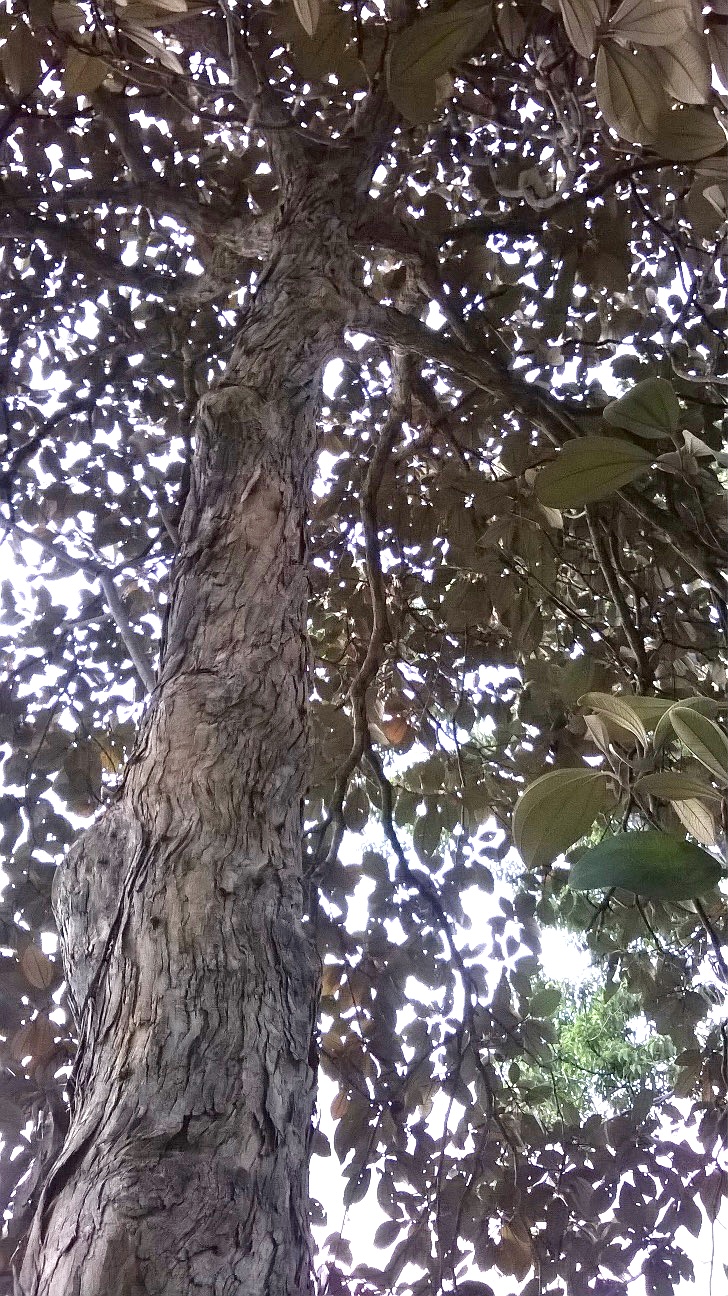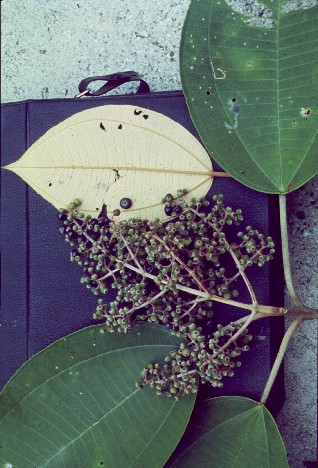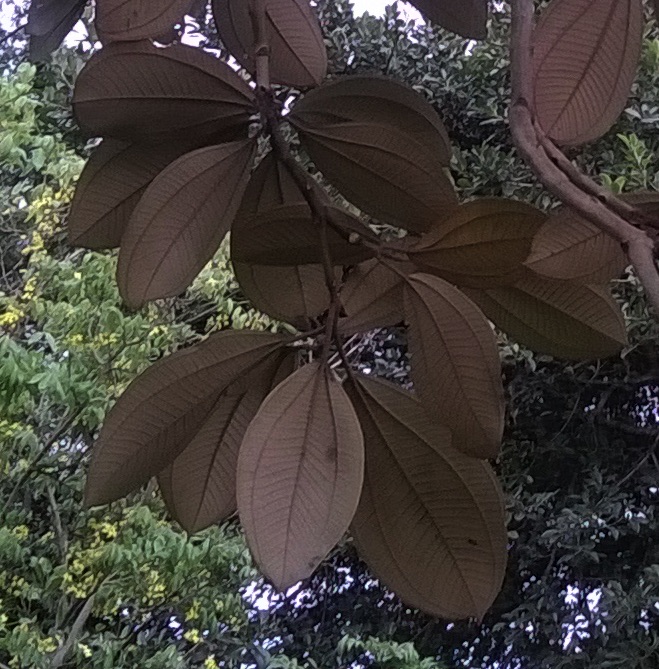Miconia argentea (Sw.) DC
Melastomataceae
LENGUA DE VACA, SANTA MARIA
Common, evergreen, understory (8-12 m) tree found most abundantly along trailsides, near old tree-falls, and amid secondary growth – where levels of insolation are high. This tree is especially important as a source of fruit and nectar for wildlife. It also has unusual, bi-colored foliage that makes for easy identification.
Description: Lengua de Vaca has a mostly straight trunk with an irregular, not quite circular cross-section. Usually a small tree, it’s diameter may rarely reach 25 cm. Bole bark exfoliates in thin, papery flakes and its light, creme-white or tan hue is uniquely characteristic and identifying. Upwardly angled limbs occur along the top half of the bole and they form a rounded crown of moderate density. A fine, but thick, pubescence coats the twigs as well as the undersides of the leaves.
Leaves are simple, opposite, elliptical and large: measuring 25 by 13 cm. At the end of a long petiole (5 cm), the serrate or denticulate margins of each blade converge in a small drip-tip. Furthermore, the blade is prominently marked (in typical Melastomataceae fashion) by a series of five, palmate main veins and many parallel secondary veins. More obvious and eye-catching, however, is the contrast presented by the two-toned nature of the Lengua de Vaca leaf: it has a vividly green upper surface and a flat-tan inferior one.
Flowers are borne from large terminal panicles (14 cm). Appearing as early as October, the slow growing globular buds take about two months to mature. When they finally open, small (0.8 cm) white blossoms are the result, each with five petals that fold back around the calyx. Still, the long, strongly-crooked stamens and prominent central pistil dominate the blossoms and, taken together, they give the panicle a fluffy appearance. Short bursts of sporadic activity punctuate Lengua de Vaca’s extended flowering season which lasts from late December through April. Blossoming intensity appears to peak twice, during these same two months. Fruits (0.5 cm) develop rapidly after the flowers die. Initially green and globular, the small berries mature dark purple or black. These edible fruits resemble small blueberries in their sweet flavor and shape. The seeds within the fruit are small, multiple, and almost undetectable. Harvests occur annually, from March to early June.
Similar Species: Most trees of the Melastomataceae family possess foliage with the same distinctive leaf vein pattern. In this arrangement, five main ribs emerge palmately from the leaf base and extend the entire length of the blade: one centrally, two along the margins, and two in intermediate positions. These primary veins are then interconnected by short, parallel secondary veins – segregating the leaf into many small rectangles. The unique, bi-colored nature of Lengua de Vaca foliage should help to distinguish this species from other members of the Melastomataceae family present in Manuel Antonio National Park (MANP).
Natural History: Lengua de Vaca flowers are pollinated by birds (e.g. Green Honeycreeper, Blue Dacnis) and bees (e.g. Trigonia sp.; Croat, 1978), that visit the flowers for nectar. Fruits are dispersed by many birds and mammals that seek out the sweet, small-seeded berries for food. Among then are squirrel monkeys, and many species of tanagers (Palm, Blue-gray, Scarlet-rumped). Ecologically, Lengua de Vaca is a secondary forest species, growing rapidly in sunny sites but rarely achieving great stature. Having said this, an impressively large specimen was recently observed in Corcovado National Park’s La Leona post. This tree, far larger than any known from Manuel Antonio, was located within primary forest, several meters from a steep, well insolated bluff facing the Pacific Ocean. Over 20 meters tall and 40 cm in diameter, its crown barely reached the level of the forest canopy. The bark characteristics of this unusual individual were similarly superlative and remarkable. Thick, corky (almost spongy), and tan colored, the outer cortex sported a rough, flaky texture brought on by heavy exfoliation.
Uses: The wood of this species is extremely hard. Allen reports that it is fine textured and easy to work, though not durable and therefore not used. Lengua de Vaca fruits are edible, sweet, and small-seeded.
Distribution: In MANP, Lengua de Vaca is found along trailsides and in light gaps in the forest. In ranges from southern Mexico to Panama.




